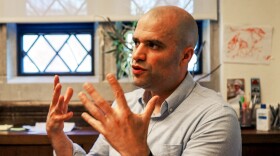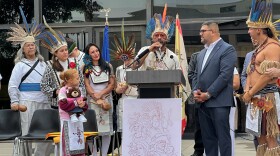“With three suitcases and God’s blessing,” Xaimar Cruz Cruz left Puerto Rico for Connecticut after the passage of Hurricane Maria, whose eighth anniversary was Saturday, Sept. 20th.
She has three daughters, is a single mother and a native of Guayama, just off the southeast coast of the island and near Yabucoa, the town through which the eye of the cyclone came through that day in 2017.
“I didn’t say goodbye.... I didn’t say ‘goodbye’ to my parents; I just told one of my brothers ‘take care of them,’ and I got out of there,” she expressed, moved, via telephone to El Nuevo Día.
Cruz Cruz recalls having to travel up to two hours to try to contact his family, at a time when 95.6% of the telecommunications towers were out of service. In one of those searches, she managed to get a call with relatives living in Connecticut.
“Every day it was more dire, there were no resources and there was so much pressure to see my daughters...so I had to make the decision, but, to this day, I struggle, and it still hurts,” she admitted.
It is estimated that more than 300,000 Puerto Ricans moved to the United States in the aftermath of Hurricanes Irma and Maria. A survey funded by the Hartford Foundation for Public Giving (HFPG) found that about 13,000 left for Connecticut.
“They started arriving in November, many to live with relatives, but almost all of them went to other states or returned to the island, and only about 5,000 or fewer stayed,” said Charles Venator Santiago, one of the report’s authors and founder of the Puerto Rican Studies Initiative of the University of Connecticut.
The HFPG study revealed that the main towns of origin of the Puerto Ricans who emigrated were Ponce, San Juan, Guayama, Humacao, Cidra, Aibonito, Caguas, Morovis and Toa Baja.
“They arrived in the middle of winter, many in sandals and without cold weather clothing. They lived in hotels for months, but they quickly asked where they could work," said Aura Luz Alvarado, director of community relations for the Capital Region Education Council (CREC).
In November 2017, CREC inaugurated what was the Centro de Ayuda Para Nuestros Amigos Caribeños, a space to support these families.
In five months, they raised more than $150,000 and helped 653 families and 2,612 individuals, “two or three people from the Bahamas, but, in reality, almost all Puerto Ricans,” Alvarado said.
“At the time, I was open to moving anywhere in the United States, until I got a call from an aunt who lived in Connecticut more than 30 years ago,” recounted Bianca Noroñas Lebrón, a native of San Juan who emigrated to Hartford.
Noroñas Lebrón had a 3-year-old daughter – now 10 years old. The deterioration of health and educational services, she said, made her decide “to look for a better future for her child”.
“They even helped me with the first month’s rent for an apartment and to get health insurance,” she said.
According to the HFPG survey results, 70% of the Boricua families who came to Hartford, where 37% of the population is Puerto Rican, had incomes of less than $24,999 annually. This, in a scenario where the median income of the state’s population is $91,665.
“I interviewed about 10 elderly couples who told me they were living on $5,000 a year,” said Venator Santiago.
CREC mobilized 380 volunteers and coordinated the work of eight local and state agencies to gather essential resources and donations, including the American Red Cross and the Federal Emergency Management Agency.
“We helped them with the cost of deposits for the apartments, to get their licenses, and we did activities for the children, such as Three Kings Day,” Alvarado added.
The Connecticut government also allocated $4.4 million to help those displaced by Maria. Of that budget, $1.5 million was for welfare and housing needs, $2.9 million for school systems and $500,000 for community entities.
In that regard, the Hartford Public Schools district inaugurated the “Step by Step” program seeking to recruit Puerto Rican teachers for the sudden arrival of 459 Puerto Rican students after the hurricane.
For those who have left, the same question always haunts them: “Do you want to go back to Puerto Rico?
Cruz Cruz would like to return.
“I have the experience in the field of social work to work there. I have been applying, but they don’t call me. Besides, the minimum wage versus the cost of living doesn’t suit me,” she said.
In Puerto Rico, she worked as a cashier at a megastore at night. She says it's clear that the opportunities she has in Connecticut, she will not have on the island.
“And I witnessed all the rows of pallets of aid that we gathered here to send to the island. When we saw on the news that they were hiding them, that hurt us so much, it was a terrible situation, but we are still here," she said.
This motivated her to continue working with society. Now, she collaborates with non-profit organizations as a community support and case management specialist.
One of her daughters graduated from high school and, “the next day, she had a ticket to return to Puerto Rico, she never adapted. The youngest, on the other hand, speaks almost no Spanish.
Cruz Cruz’s parents tell her not to come back, that the island “is getting worse and worse”.
Norañes Lebrón, meanwhile, is now director of the Hispanic Health Council’s Maternal and Child Center, where she volunteered when she arrived in the post-Maria state.
“That encouraged me to want to get my master’s degree in public health,” she recounted.
In her case, she and her daughter have made “a lot of progress,” but do not envision returning to Puerto Rico, although she says that it's still emotional and difficult to deal with missing home.
“There are days when you wonder what progress is, whether it’s what you achieve or love for your family, and you’re left with those internal struggles wondering ‘what am I doing here’ or ‘why didn’t I stay there,’ but it’s not that easy,” she finished, shaken.




